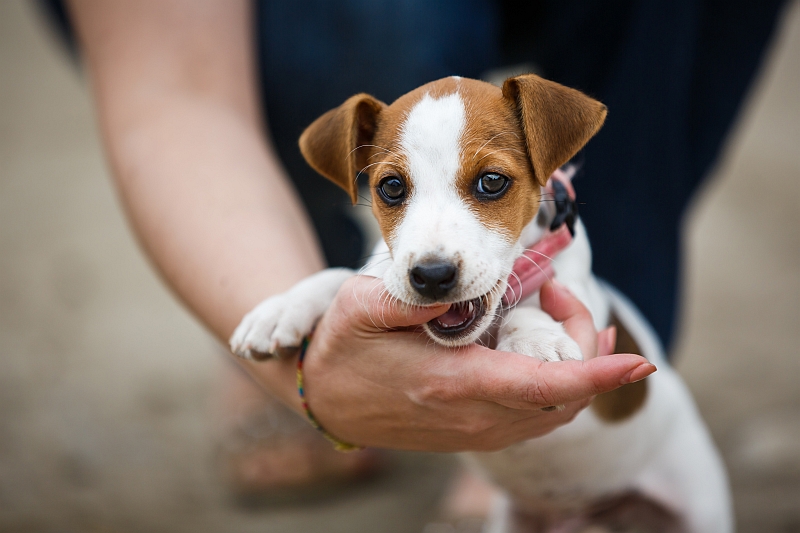Dogs that bite can pose a great risk to people in the household, visitors, and strangers, so it is important to deal with this issue as swiftly as possible as soon as it starts so that it does not develop into a major behavioral problem.
Puppy Mouthing & Biting
There are two types of issues that dog owners may face when it comes to puppy bites: actual bites, and puppy mouthing.
The most important aspect of training a puppy to stop mouthing, nipping, and biting is to teach him that human skin is much more sensitive than that of a dog, and even regular roughhousing that might be ok with a puppy sibling, can be painful to humans.
To teach a puppy about appropriate amount of force you can allow the puppy to playfully mouth your hand until he bites in a way that is painful; at that point you will need to let out a short yet sharp yelping sound, let your hand go limp, and then pull back (don’t pull back if he is holding on). Stop play completely and move away from the puppy. This will help the puppy realize that bites that are too hard cause pain and discomfort, and he will eventually learn to moderate his bite as to only be playful and not cause pain or break skin. If you notice that the yelping is not having an effect, then you can use a time-out instead of the pulling back to help the puppy understand that if he bites, play time will end, and he will be put in a time-out.
If mouthing and nipping turns into bites out of fear and frustration, if not addressed properly the behavior can transform into aggression during adulthood which can be much more problematic. These types of issues are best handled by a trainer or behaviorist, so it’s best to contact a professional.
See our extensive how to article on breaking puppy biting habits.
Adult Dog Mouthing & Biting
As with puppies, if the biting behavior of an adult dog is the result of aggression, it is important to contact a professional trainer or behaviorist to deal with the problem
In adult dogs it is important to figure out what triggers biting behavior, if the bites are a result of bad or lack of training (i.e. if you got an adult dog that didn’t receive bite inhibition as a puppy), then you can use a process similar to training puppies, but naturally it will be necessary to make some adjustments as an adult dog can cause serious damage by a hard bite.
Ideally, you should start by training your dog using a toy so that if any biting does occur is it not as a direct result of biting on your hand.
Figure out what elicits play-biting from your dog, and what level of stimulation is required for your dog to reach a level where he is at a point where he cannot control his biting behavior. Once you have this figured out, get the dog excited enough so that he reaches this level, and then while he is on a leash, introduce a toy to him from a hiding position (behind your back), as soon as the dog starts to take the toy with its mouth, giving a verbal correction command, and pull down on his leash, while hiding the toy behind your back at that very moment. This process should be repeated until the dog knows that he is not allowed to put the mouth on the toy when presented to him. Once the dog is able to wait and not mouth/bite the toy, then say ‘take it’ (or any other short command you would like to use), and allow him to take the toy. Praise him when he does.
It is very important to not let instances of his teeth touching your skin go without directly dealing with the instance. Do so by, correct verbally with a firm tone, and a drop (meaning the toy), and down command (use your leash to enforce the down command). Keep the dog in the down position for 30-40 seconds, and then give the take command again and allow the dog to take the toy.
This process should be repeated until the dog clearly understands that he is not allowed to take anything unless specifically given the command to do so, and that touching human skin with teeth is absolutely forbidden.
It is worth repeating that if you are not comfortable doing the training or if there are aggression problems with an adult dog, it is necessary to retain the services of a professional dog trainer or behaviorist.

